May 23, 2023
Multichannel Microphone Array Design (MMAD)
Multichannel sound recording
By Michael Williams and Guillaume Le Dû
Introduction
Multichannel sound recording systems are as subject to the basic rules of sound recording as any other recording system, be it monophonic or stereophonic. The microphone or microphone array will need to be nearer the sound source to obtain the same sound perspective compared with perception by the normal hearing of the actual sound source. The perception of distance is, as usual, a function of direct-to-reverberant sound and, therefore, directly influenced by the directivity of the microphones used in the system. The advantage of the multichannel surround sound environment is that we are able to “envelop” the listener as much as we consider desirable. In achieving this aim, we are not limited to the front-facing triplet of microphones and loudspeakers to create our main sound stage, for this would create limits to the main sound stage and be a little better than the traditional stereophonic reproduction. However, this front perception zone of about 60° seems to satisfy approximately our needs as to the angular size of the main sound stage, but with multichannel continuous sound field recording and reproduction, we have the freedom to be able to widen this sound stage if we feel the need.
The stereophonic listening configuration severely limits the sound recording engineer in the reproduction of early reflections and, of course, in the reproduction of the surrounding reverberant sound environment (4). The process of MMAD shows how it is possible to design multichannel arrays that are capable of giving complete freedom for the sound engineer to spread the main sound stage over any desired angle and to integrate both first reflections and reverberation whilst maintaining their natural acoustic structure. This is another major step towards achieving perfect reproduction of the sound environment. We must also be able to use this type of sound recording system in the recording of contemporary music which will often make use of the surrounding sound space, and of course, sound effects and ambience where sound should be localised correctly within the total surrounding sound field.
But don’t be deceived, the achievement of this aim needs very careful adjustment of the parameters of the microphone array and a clear understanding of the fundamental characteristics of each segment of the array. It must also never be forgotten that, as with stereo, the microphone array will pick up not only sound in the horizontal plane around the array but both above and below the system (12). This sound will obviously be reproduced only in the horizontal plane of the reproduction system. We must, therefore, not lose sight of the fact that even multichannel surround sound recording and reproduction systems still have some limitations to the impression given of natural reproduction of the total sound field.
Segmentation of the Sound Field
At the 91st AES Convention (New York – 1991), in a paper entitled “Microphone Arrays for Natural Multiphony” (5), the author (Michael Williams) described the development of three microphone arrays suitable for recording/reproduction systems using four, five or six channels. At this time the author considered the associated loudspeaker layout to be perfectly symmetrical, the reproduced surround sound field being generated by loudspeakers placed on a circle divided into equal segments in the horizontal plane. Also, the recording/reproduction system was based on a univalent or one-to-one microphone/loudspeaker relationship. The characteristics of a specific microphone array covering a given number of segments were determined from the intersection of the physics of the microphone array with the psychoacoustics of the listening configuration. This approach was conceived, for the four-channel system, purely as an extension and improvement of the original Quadraphonic Recording/Reproduction System, and it seems, was somewhat in advance of the multichannel systems now required.
Although a similar approach by segmentation of the sound field is used in Multichannel Microphone Array Design (MMAD) (8), almost complete freedom can be obtained in the relation to the physical angle between the microphones with respect to the corresponding segment coverage angle. A detailed analysis will show how to “link” segments without overlap and obtain a smooth continuous reproduction of the total sound field.
The standardisation in the context of multichannel reproduction in relation to surround sound for audio-visual applications has since modified considerably the layout of the sound field segments. This, together with an ever-increasing interest in the use of multichannel systems for the reproduction of music as a purely audio media, has shown the need for a clear and unambiguous analysis of the psychoacoustics of reproduction in a multichannel environment in order to help in the development of microphone arrays that can meet the need for specific sound field segment pick-up and reproduction.
In Stereophony, considerable use has been made of Intensity Difference, Time Difference and combined Intensity/Time Difference systems to pro- duce reasonably satisfactory microphone systems for the recording and reproduction of the sound field. In previous AES papers (1) (2) (3) (4) (5) (6), the author has shown how a multiplicity of dual microphone arrays can be developed to enable the sound recording engineer to choose the best configuration for optimum stereophonic results in a given set of conditions. This same approach has been applied to microphone arrays for multichannel systems.
It is a convention established in previous AES Convention papers (1) (2) that the Stereophonic Recording Angle is always specified, for instance, as +/- 50° to avoid confusion with the angle between the microphones. However, in the case of Multichannel Microphone Arrays, we no longer have a symmetrical recording/reproduction sound stage in relation to each of the array segments, so it would seem necessary to change terminology and use the idea of Coverage Angle to mean the total coverage of the Stereophonic Recording Angle of a single pair of microphones making up part of the total Multichannel Array. In the above example, the SRA of +/- 50° becomes a Coverage Angle of 100°.
Back to Basics
It should not come as any surprise to the initiated that we must first deepen our knowledge of the characteristics of a simple pair of microphones, reproduced evidently by two loudspeakers. In the context of stereophonic reproduction, left/right symmetry of the reproduced sound field is, in general, obviously desirable. The sound field reproduced by the loudspeakers can be either smaller or larger than the physical angle between the axis of directivity of the microphones and is usually disposed symmetrically on each side of the physical axis of the pair of microphones.
However, in the design of multichannel microphone arrays, we must have complete control over the angular offset of the reproduced segments of the sound field in relation to the axis of symmetry of the microphone pair covering each specific segment. In the design of the front-facing triplet of microphones covering the left and right front segments, we must be able to offset the reproduced sound field segments so that the side limits of the left and right sound fields correspond to the axis of the front-facing centre microphone. For the lateral segments, however, we need to be able to rotate freely the coverage of the side segments without any coincidence between the physical axis of the microphones and the limits of each of the sound field segments.
And finally, for the back segment, we return to the simple symmetrical segment as used in stereophony.
Offset and Linking
The application of Offset is illustrated in Figures 1 to 6.
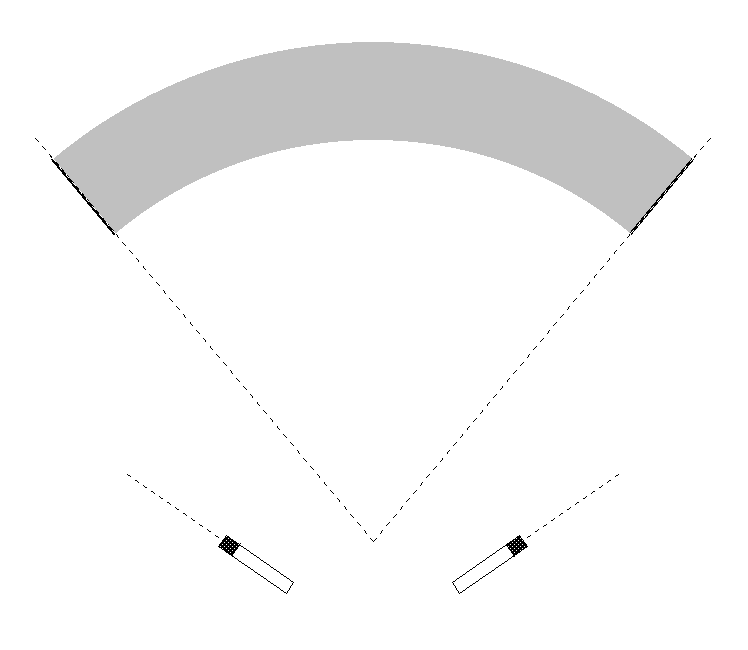 Caption Figure 1 Stereophonic Recording Angle (SRA) less than the angle between microphones
Caption Figure 1 Stereophonic Recording Angle (SRA) less than the angle between microphones
Figure 1 shows the standard Stereophonic Recording Angle (SRA) where it is less than the physical angle between the microphones.
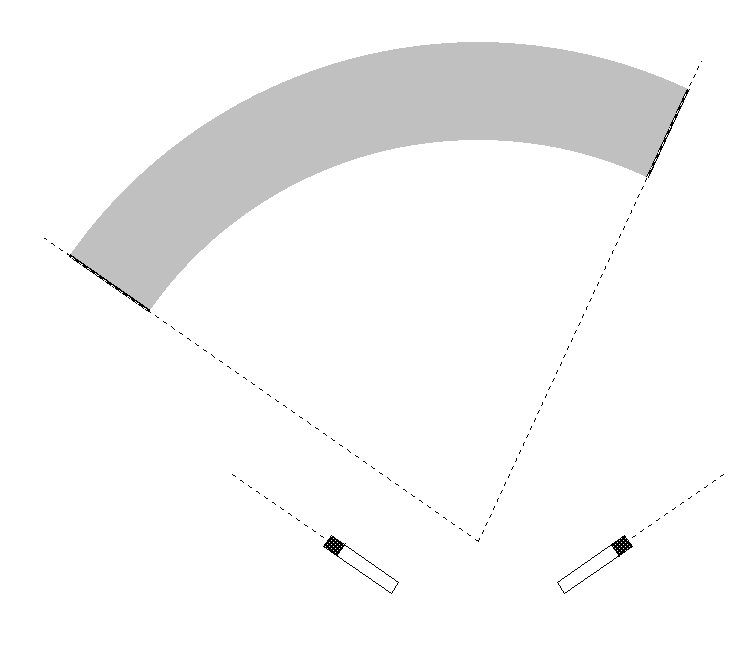

Figures 2 & 3 show how this same sound field coverage can be rotated in an anti-clockwise direction, that is, using a negative angular offset.

Figure 4 shows an SRA that is larger than the angle between the microphones.
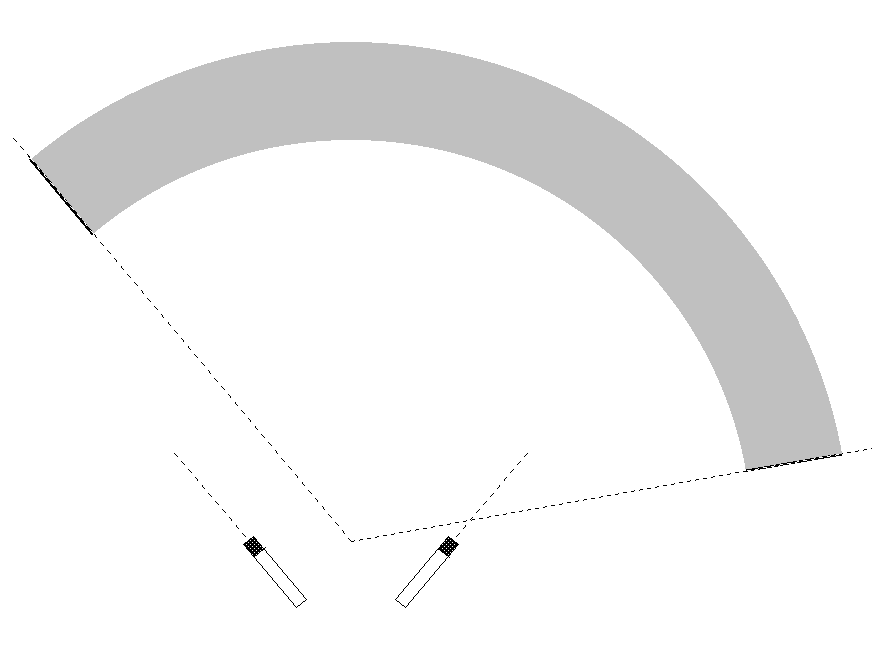
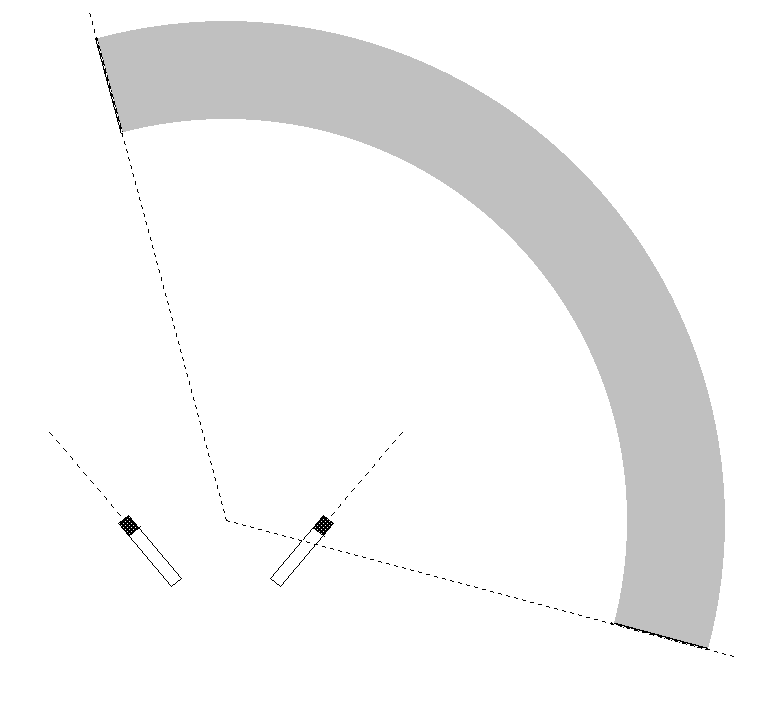
Figures 5 & 6 show the same principle of offset, but using, this time, a clockwise rotation or positive angular offset.
In these Figures (1 to 6), the Stereophonic Recording Angle has been drawn with its true origin on a line between the two microphone capsules. In practice, this is an approximation that is justified because the sound source is usually much further away from the microphone system than the distance between the microphones. If the distance of the sound source is relatively near the microphone source, then the analysis becomes much more complicated as the microphone system is no longer within the zone of plane wave sound field propagation.
In Figure 2 and in Figure 5, we see that the left limits to the SRA are aligned (or parallel) with the axis of the left microphone.
The process of linking is represented in Figures 7 to 10. As the sound source is relatively far away compared with the distance between the microphones, it is an acceptable approximation from now on to draw the graphical origin of the SRA coverage at the intersection between the microphone axes. This enables us in Figures 8 & 9, and thereafter, to illustrate more clearly the process of linking that is an essential characteristic in the design of a multichannel microphone array for smooth and continuous coverage.
Figure 7 shows the front triplet of a Multichannel Microphone Array. We can see that we have microphones facing both towards the left-hand side and right-hand side, forming left-facing and right-facing pairs by sharing the centre microphone.

In Figures 8 & 9, we show how to link the SRAs of each pair to produce continuous coverage of the front sound stage. Figure 8 uses the link between two SRAs that are each smaller than the physical angle between the microphones that make up their respective pairs. We need to use Positive Angular Offset on the left segment and a Negative Angular Offset on the right segment to critically link the two segments. However, in Figure 9, the link between the two SRAs is larger than the angle between the microphones. Therefore, we use a Negative Angular Offset on the left segment and Positive Angular Offset on the right for correct linking. Through this process, we can create a front triplet with any desired coverage angle, thereby giving more flexibility to the sound recording engineer in setting up the coverage of the main front sound stage.
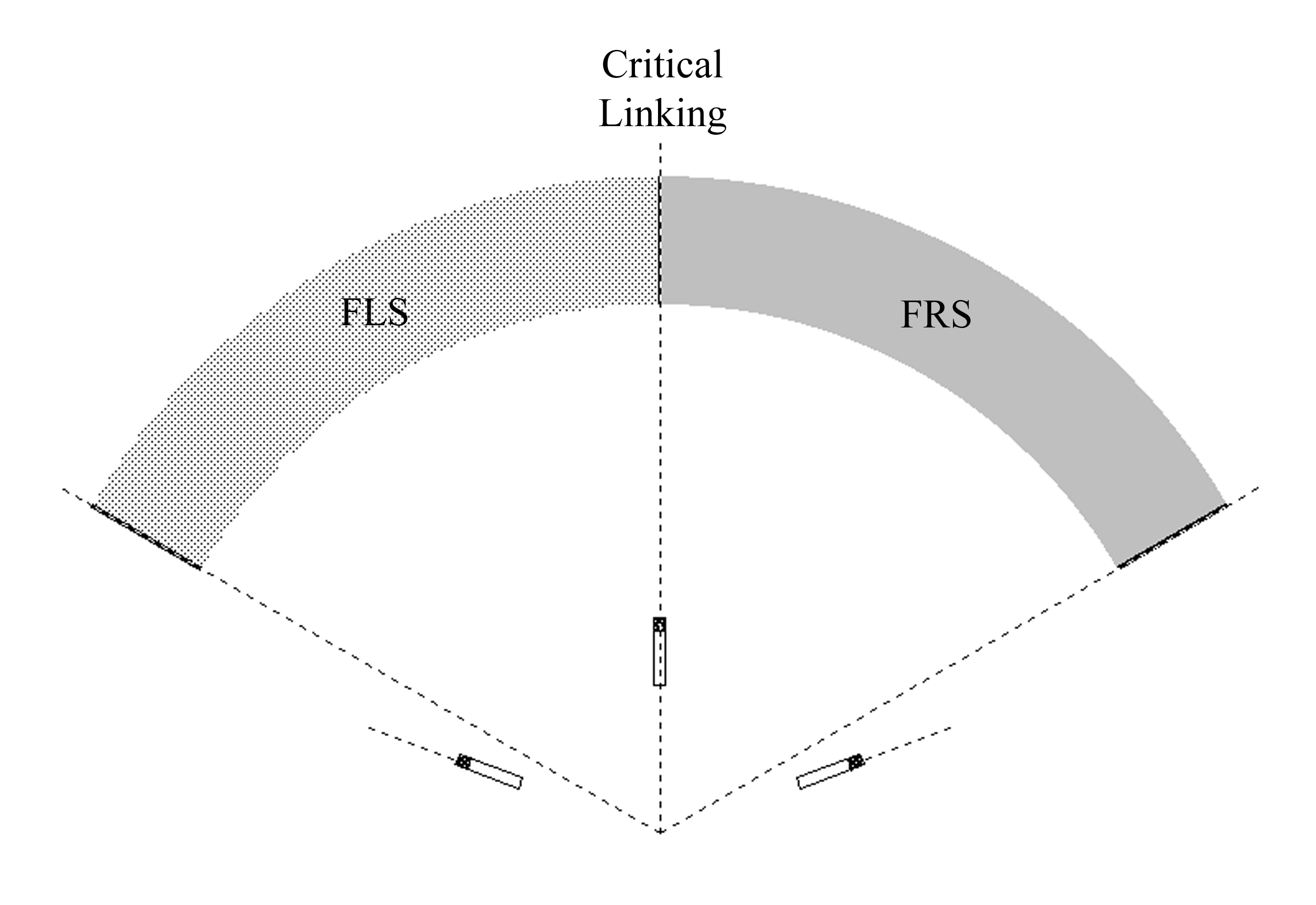

Figure 10 shows how this process of linking is applied for the complete Multichannel Microphone Array. Only the front-facing centre microphone is aligned with the linking of two segments, i.e., the link between the Front Left Segment (FLS) and the Front Right Segment (FRS). The Back Segment (BS) is usually symmetrical with respect to the back axis of the system.
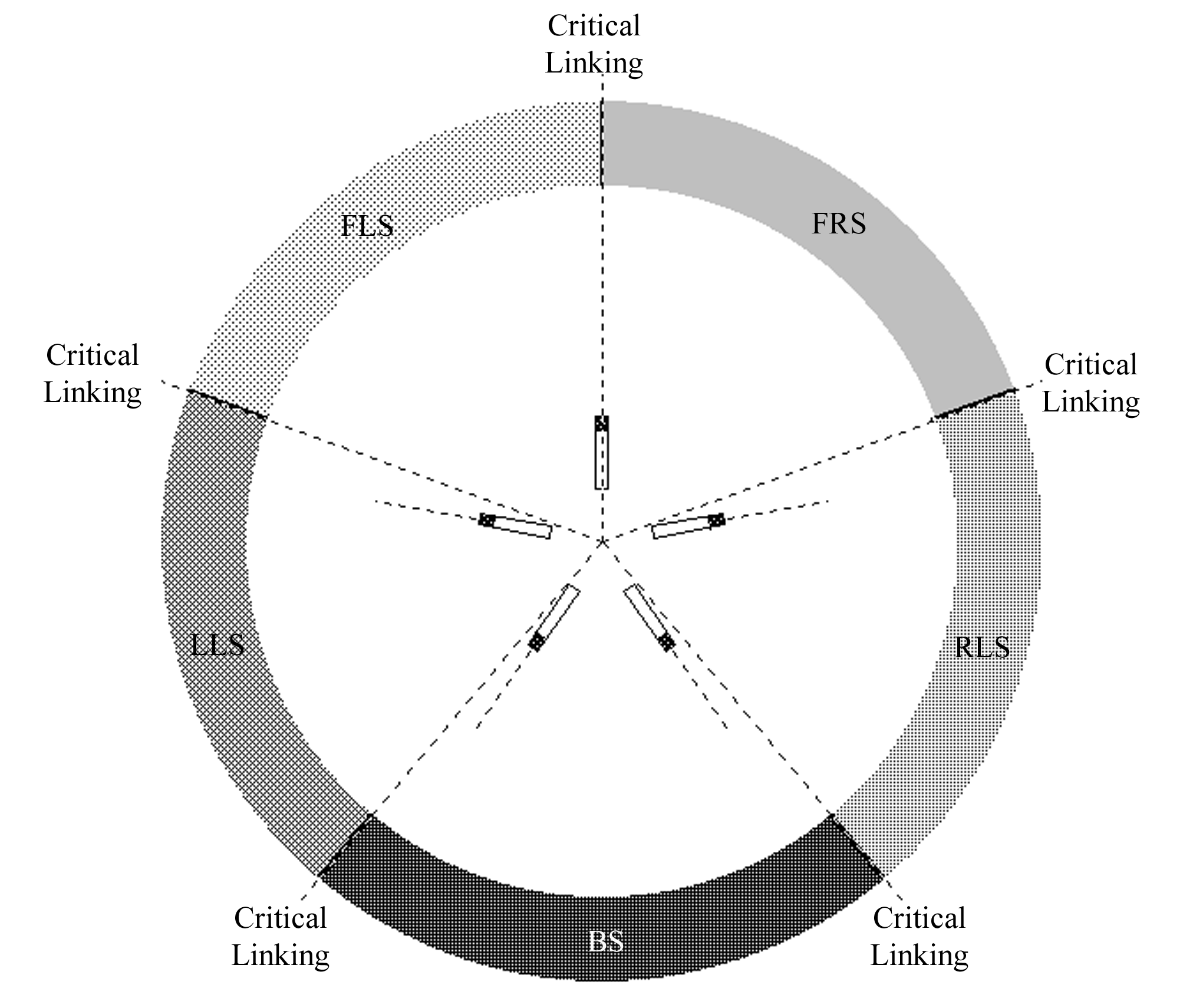 Figure 10
Figure 10
Critical linking between all segments of a Multichannel Microphone Array
Intensity and Time Offset Generation
The method used to produce this offset technique is, in fact, remarkably simple, both in theory and practice. The difficulty comes in the choice of specific offsets so that « critical linking » is obtained, and smooth and continuous sound field reproduction is achieved. Basically, there are four different types of offset that we can apply:
-
Electronic Intensity Offset – addition of a constant Intensity Difference to the Intensity/Time Difference function between two microphones
-
Electronic Time Offset – addition of a constant Time Difference to the Intensity/Time Difference function between two microphones
-
Microphone Position Intensity Offset
-
Microphone Position Time Offset
These last two offsets are one and the same, as it is just a question of one type of offset relative to the other. Creating a Microphone Position Intensity Offset in one direction is equivalent to creating a Microphone Position Time Offset in the other direction.
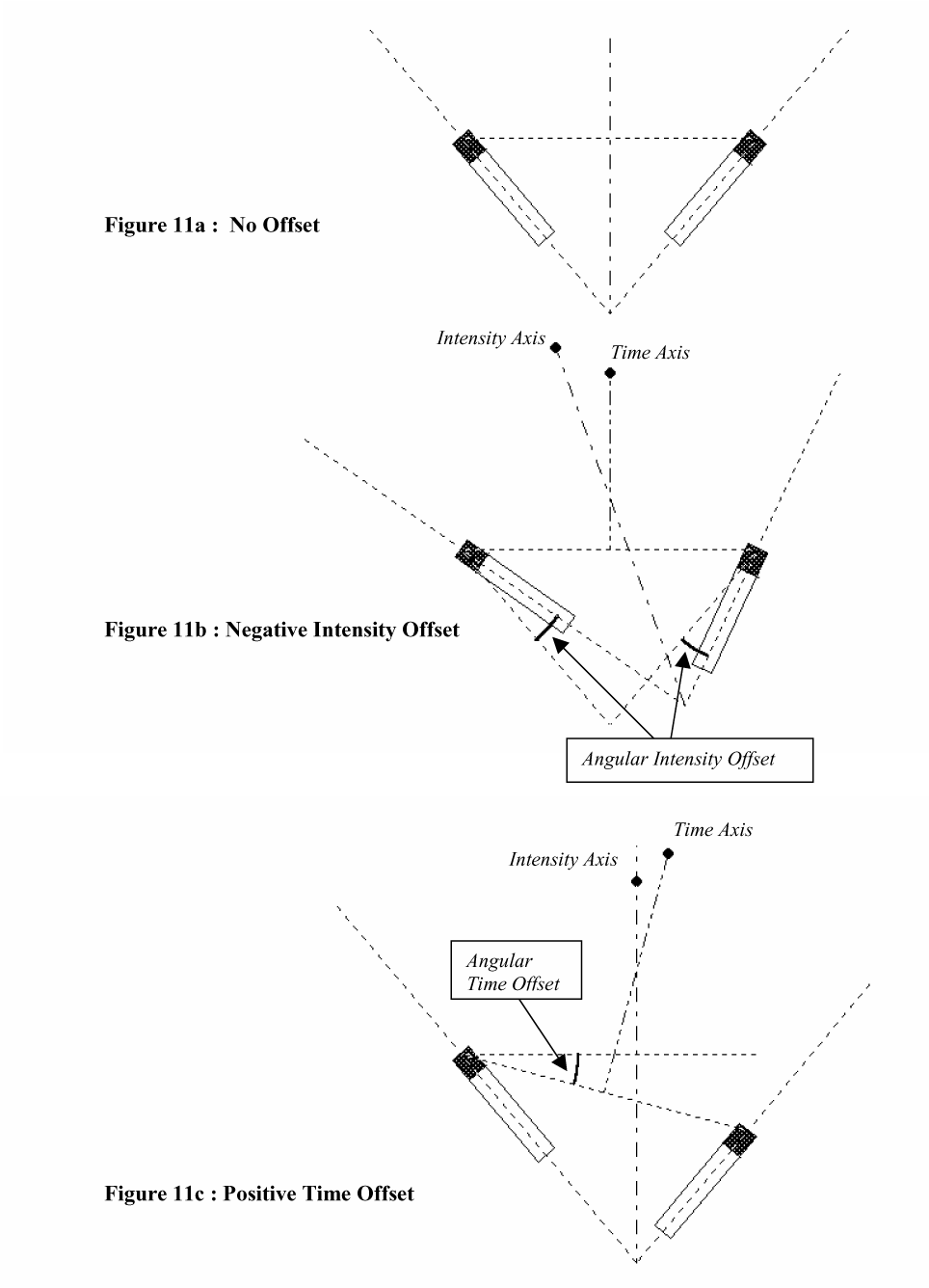 Figure 11
Figure 11
Figure 11 illustrates the analysis of this Microphone Position Offset, but seen from two different points of view:
-
Using the microphone diaphragm as the centre of rotation for each microphone, we can consider that both microphones have been rotated 15° in an anticlockwise direction (Figure 11b), thereby also rotating the Intensity Axis (DI=0) anticlockwise by the same amount, i.e., Negative Micro- phone Position Intensity Offset.
-
Or we can think of the right-hand microphone as having been moved backwards whilst maintaining the same distance between the microphones (Figure 11c) – the time axis (DT=0) has therefore been rotated 15° in a clockwise direction, i.e. Positive Microphone Position Time Offset.
It is agreed that the trigonometric analysis of these two interpretations is somewhat complicated, but the practical end result is exactly the same, i.e., the orientation of the Intensity axis relative to the Time axis is the same.
There is, however, a subtle difference between Electronic Offset and Microphone Position Offset.
-
Electronic Offset is simply the addition of a constant value of Intensity Difference or Time Difference to the Intensity/Time function of a pair of microphones covering a particular segment.
-
Microphone Position Offset is created by changing the physical position of the microphones forming the pair, thereby creating an angular difference between the Intensity and Time axes.
Let us be clear on the convention that has been adopted for Positive and Negative Offsets: Positive Offset is defined as that offset which produces a rotation of the Coverage Angle in a clockwise direction.
-
This is obtained in the case of a Positive Electronic Time Offset by introducing a delay in the right-hand microphone in relation to the left-hand microphone.
-
Similarly, with Positive Electronic Intensity Offset, the right-hand microphone is attenuated in relation to the left.
-
With Positive Microphone Position Time Offset the right-hand microphone is rotated clockwise (i.e. backwards) using the centre of the left microphone diaphragm as the centre of rotation whilst maintaining the same distance between the microphones and the angle between the axes of the microphones.
Each of these different positive offsets will produce a shift in their respective Intensity/Time function graphs either to the left for Positive Time Offsets or downwards for Positive Intensity Offsets. This can be a little disconcerting at first; however, the sound position coordinates show the relative position of the Coverage Angle, and this leaves no room for ambiguity.
Further detailed analysis of different offset functions can be found in AES preprint 4997 (8).
The process of Multichannel Microphone Array Design is highly complex due to the interaction of the many parameters that are involved. It would seem almost impossible to envisage undertaking the complete multichannel design process just before the beginning of a recording session. Unfortunately, this is the moment when the sound recording engineer is more or less in possession of the complete range of characteristics of the sound field to be recorded. The rest of this document will present a quick reference guide to some different Multichannel Microphone Array configurations to assist the sound engineer in quickly choosing a system adapted to each particular circumstance. These Multichannel Microphone Array configurations were first presented in AES preprint (11).
All systems described present good Critical Linking; i.e., the reproduction of the sound field is continuous without any « holes » or « overlaps ». However as a complete description of each system would require as many pages as there are systems, it was considered more reasonable to present the characteristics of each of the arrays grouped within a table covering each specific value of Front Triplet Coverage. Within each of these Front Triplet Coverage values, a range of possible combinations are suggested.
In general, Microphone Position Offset is used to obtain Critical Linking of the Front Triplet Segments, whereas Electronic Time Offset is normally required to obtain Critical Linking of the Lateral Segments. Microphone Position Offset, as its name implies, is obtained purely by the correct position and orientation of the microphones in the array; however, Electrical Time Offset needs specific time delays to be introduced into certain channels. The sound recording engineer does not always have the possibility to adjust Electrical Time Offset with the equipment available for a recording session. For this reason, a few selected arrays have been described which have Natural Critical Linking, i.e., the parameters of the array have been chosen so that no electrical offset is necessary to obtain Critical Linking. The orientation of each microphone and their corresponding « X » and « Y » coordinates are the only parameters that have to be set up to obtain Critical Linking with these specific arrays.
The concept of Critical Linking means that the impression of a continuous sound field is reproduced no matter what the orientation of the listener within the loudspeaker set-up. This allows a certain freedom of rotational movement of the head but does not obviously change the need for the listener to be in the centre of the loudspeaker system, commonly called « the sweet spot ». But « Oh! How sweet » is this experience with a good recording made with a correctly designed Multichannel Microphone Array!
MMA design procedure
General Overall Strategy
As with the choice of a dual microphone array for stereophonic sound recording, the first stage of array design is to determine the probable position of the microphone system and, therefore, to measure the angle of the sound source as « seen » by the microphone array. With a stereophonic microphone array, the Stereophonic Recording Angle (SRA) is chosen according to the amount of « side room » to be left on either side of the sound source. In general, a small musical sound source such as a quartet needs an SRA that is about 10% wider than the actual sound source (the extra 10% on each side is called the « side room »). However, for a wider sound source, such as a Symphony Orchestra, the SRA is usually about 10% smaller than the total sound stage. This enables better resolution in the centre part of the orchestra, but obviously to the detriment of the extremities of the orchestra, which will become somewhat crushed onto the left and right loudspeakers in stereophonic reproduction.
With the Multichannel Microphone Array, we have the added advantage of a wider reproduction stage. We are, therefore, not limited to the 60° of stereophonic reproduction. Although the complete use of the side segments for direct sound is not advisable due to the progressively worsening localisation characteristics on the side, it is nevertheless possible to exploit the sound reproduction further than the « 30° + 30° » defined by the front three loudspeakers. A 10° or 20° spread of the sound source into the lateral segments is possible, with the added advantage of a better feeling of envelopment of the listener and, of course, considerably better reproduction of early reflection groups. However, it remains to be seen as to precisely how much more spread is possible with a wide sound source and also whether we still need to stay within the front 60° with the smaller sources. In practice, this obviously means that we need to use a Multichannel Microphone Array that allows us to fully exploit the recording and reproduction characteristics of the lateral segments.
In the design of a dual microphone pair for stereo-phonic sound recording, complete freedom exists to choose any combination of distance and angle for the desired Coverage. This allows the sound engineer to choose any system from coincident directional microphones through hybrid combinations of distance and angle to the purely time-dependent spaced pair of omnidirectional microphones. In the multichannel array design, a purely intensity-dependent system is not feasible if we are looking for a Critically Linked surround sound system. However, careful examination of the multichannel microphone array configurations presented in the tables will demonstrate that it is possible to select systems that have either Time or Intensity Dominance according to the options chosen in design. It remains to be seen whether a Time Dominant or Intensity Dominant system is preferable for better localisation in the lateral segments.
The completely «surround sound» characteristics of natural reverberation mean that a continuous sound field pick-up around the array becomes a necessity. Attention to Critical Linking, therefore, becomes of paramount importance and must therefore be integrated into the total process of Multichannel Microphone Array Design presented in this document.
The majority of musical sound recording situations that we encounter concern the reproduction of a limited sound stage as seen in the concert hall or theatre. The research for a satisfactory reproduction of the completely surrounding direct sound source, although technically very challenging, is not part of our daily bread.
In general, the Multichannel Microphone Array has a considerable wing span somewhat like the proverbial « albatross ». However, careful analysis of the many arrays presented in this paper will show that this is not always the case. There are also some circumstances, for instance, when a minimum of physical size is important, in which case it is necessary to neglect the reproduction characteristics of the lateral segments. But we are perforce limited to the 60° of the front sound stage (as with the standard stereophonic sound stage) created by the front three loudspeakers, and the far from satisfactory 140° of the back segment reproduction. However, in this document, we are only concerned with good continuous reproduction of the total surround sound environment.
This still leaves us with the first major decision as to what coverage angle to adopt relative to the direct sound from the sound source. There are no rules as to how to go about setting up a microphone array for a multichannel sound recording system. Each sound recording engineer will have his own ideas and preferences, and this is, of course, part of the art of sound recording. However, here are some guidelines as to a possible procedure:
-
Determine the probable position of the microphone system.
-
Decide on the required reproduction angle of the direct sound source. This will determine the Coverage Angle of the Front Triplet Array. Remember that the Front Triplet Coverage will only be reproduced between the front three loudspeakers. Further “spread” will concern the side segments. If the Front Triplet Coverage angle is smaller than the sound source, then in reproduction, there will be spread into the side segments. If the Front Triplet Coverage is wider than the sound source, then the reproduced sound source will be within the front sound stage created by the front three loudspeakers.
-
Decide on the relative balance between Back Segment and Lateral Segment Coverage. This will determine the Back Pair Coverage characteristics.
-
Choose your own preference concerning Intensity/Hybrid/Time Dominance. It is obviously physically impossible to have Intensity or Time Dominance for both the Back Segment and the Lateral Segments; they will usually be complementary. Both can, of course, be a Hybrid combination (equal dominance between Time and Intensity).
-
Introduce, if needed, the correct Electronic Offset values between the front Triplet and the Back Pair.
-
Listen to the result! and start again until you are satisfied that you have achieved the optimum result in the circumstances.
Critical Linking with Electronic Offset versus Natural Critical Linking
The various techniques needed to obtain Critical Linking have been described in previous AES preprints (9) (11) under chapters concerning Microphone Position Time Offset (MPTO), Electronic Time Offset (ETO) and Electronic Intensity Offset (EIO). Of these different types of offset, MPTO is, of course, the easiest to generate, as it is obtained simply by the physical position and orientation of the microphone. ETO, however, requires the fine adjustment of Time Delay between the Front Triplet and the Back Pair, a facility that is not always available on the standard mixing desk or even in post-production with an Audio Workstation. On the other hand, EIO is just a matter of introducing the correct constant Intensity Difference into the microphone array within the Front Triplet or between the Front Triplet and Back Pair (EIO can be used to generate Critical Linking either in the design of the Front Triplet Coverage or in the Lateral Segment Coverage). However, it must be said that the range of Critical Linking that can be obtained with EIO processing is very much more limited than with ETO. Also, the difference in level between each component of the array may produce an undesirable imbalance between different parts of the Array Coverage. Detailed consideration of the design of this type of array using EIO is outside the scope of this paper.
Although « Natural Critical Linking » considerably limits the choice in array design, it has a considerable advantage in that no electronic manipulation of Segment Coverage is required. Critical Linking is obtained purely by microphone position and orientation, not only for the Front Triplet but also between the Front Triplet, the Lateral Segment and the Back Pair Coverage. This type of array is operational without any further signal processing. Microphone signals can therefore be recorded directly to any 5-channel recording system without the intervention of a more complex sound mixing or signal processing stage. This is obviously an important factor when doing « on-location » recording with limited studio facilities.
Tables 1, 2 & 3 show three sets of operational Multichannel Microphone Arrays where no electrical offset is needed. The combination of « Table 1a line 3 » together with « Table 1b line 3 » has already been presented in a paper given at the 91st AES Convention in New York (5) in 1992! But this was before the seeds of the multichannel market were sown.
Table presentation
Seven table groups are presented, covering over 220 possible microphone array configurations. The Front Triplet design is shown in each Table « a », whilst Table « b » describes the corresponding Back Pair and Lateral Segment Coverage parameters. It is a remarkable feature of the design process that within the same table number, a specific combination chosen from Table « b » will automatically be Critically Linked with any combination chosen from Table « a » on condition that the correct ETO has been applied. The Linking function depends on the Coverage Angle and not on the angle between the microphones. Variations of distance and angle used to obtain the same Coverage Angle will automatically Critically Link to neighbouring segments. Each « Table: a & b » will therefore cover between 30 and 36 possible microphone arrays (except for table 3 where Critical Linking is very limited and only one Back Pair configuration is shown). Two examples of microphone layouts are given in the figures immediately after each table set.
MMAD – First stage – front triplet design
The first stage in design (as explained above) is the choice of microphone array position and thereafter the Front Triplet Coverage. A wide range of Front Triplet Coverage values is presented in Tables 4 to 8, allowing the sound engineer to adjust the Front Triplet Coverage from a maximum of « 90° + 90° » to a minimum of « 50° + 50° ». Critical Linking is almost impossible for smaller values of Front Triplet Coverage.
MMAD – Second stage – back pair
The second stage in design is to determine the de- sired Back Segment Coverage. Again a wide choice of Coverage has been presented, from 90° to 40°, allowing the sound engineer to optimise the reproduction of the back segment that usually covers the reverberant field. In most cases, it is better not to overload back segment coverage as this can be somewhat disconcerting when reproduced in the segment behind the listener. This means that, in practice, it is better to choose the lower values of Back Segment Coverage that will be spread out over the 140° of back segment reproduction and, of course, includes considerable Angular Distortion (10).
MMAD – Third stage – lateral segments
The third stage concerning the Lateral Segment Coverage is usually considered to be the Coverage of the remaining surround sound-field angle and will be conditioned by the distance between the Front Triplet and the Back Pair. Critical Linking will be obtained by the introduction of the correct amount of Electronic Time Offset unless, of course, a combination producing Natural Critical Linking has been selected.
Other possible configurations
For the sake of simplicity and quick reference, only certain specific configurations have been presented in the tables, but of course, there is a multitude of other configurations possible within the continuum of possible microphone distance and angle. However, from the operational point of view, the large range of choices presented in Tables 1 to 8 should be enough to satisfy most sound recording situations.
Microphone directivity
As with the design of a dual microphone stereophonic array, we are not restricted to the use of cardioid microphones. It is the intention of the authors of this document to present, in future AES papers, not only a choice of microphone arrays using other first-order directivity patterns but also to suggest a wide range of possible hybrid arrays using different directivity patterns for each part of the array structure.
| TABLE 1a | ||||
| FRONT TRIPLET COVERAGE 72° + 72° | ||||
| Microphone orientation | Distance between microphones | X coordinates | Y1 coordinates (for both left and right microphones) | Microphone Position Time Offset (MPTO) |
| 90° (R) |
35 cm
|
+30.5 cm |
17 cm
|
-15.6°
|
| 270° (L) | – 30.5 cm | |||
| 80° (R) |
37 cm
|
+ 31 cm |
20.5 cm
|
-6°
|
| 280° (L) | – 31 cm | |||
| 72° (R) |
39 cm
|
+ 31.5 cm |
23 cm
|
No offset
|
| 288° (L) | – 31.5 cm | |||
| 60° (R) |
42.5 cm
|
+ 33 cm |
26.5 cm
|
+9°
|
| 300° (L) | – 33 cm | |||
| 50° (R) |
45 cm
|
+ 34 cm |
29.5 cm
|
+15.5°
|
| 310° (L) | – 34 cm | |||
| 40° (R) |
48.5 cm
|
+ 36.5 cm |
31.5 cm
|
+20.9°
|
| 320° (L) | – 36.5 cm | |||
From the above table (Front Triplet Coverage of 72° + 72°), note « the microphone orientation », « X » coordinates and « Y1 » coordinates for the desired configuration of the Front Triplet. Then choose any combination « distance / angle » from the table below and note the distance between the left and right Back Pair of microphones and their orientation, and the « Y2 » coordinate of the back pair (with respect to the front-facing centre microphone). This is all the information that you need to set up this « no offset » array which covers the complete surround sound field in five equal segments of 72° each.
| TABLE 1b | ||||||
| LATERAL PAIRS | BACK PAIR | |||||
| Lateral Segment Coverage | Electronic Time Offset (ETO) | Back Segment Coverage | Mic orientation | Angle between mics | Distance between mics | Y2 coord |
|
72°
|
No offset
|
72°
|
160°(R) |
40°
|
48 cm
|
58.5 cm
|
| 200°(L) | ||||||
|
72°
|
No offset
|
72°
|
155°(R) |
50°
|
45 cm
|
59 cm
|
| 205°(L) | ||||||
|
72°
|
No offset
|
72°
|
144°(R) |
72°
|
39 cm
|
60 cm
|
| 216°(L) | ||||||
|
72°
|
No offset
|
72°
|
135°(R) |
90°
|
34.5 cm
|
62 cm
|
| 225°(L) | ||||||
|
72°
|
No offset
|
72°
|
130°(R) |
100°
|
32 cm
|
63.5 cm
|
| 230°(L) | ||||||
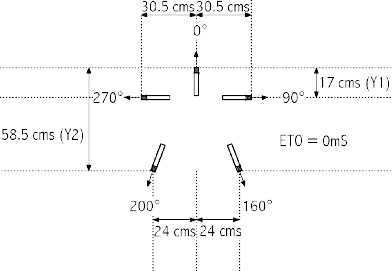
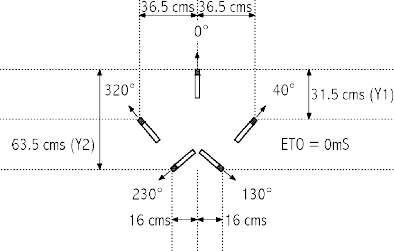
| TABLE 2a | ||||
| FRONT TRIPLET COVERAGE 60° + 60° | ||||
| Microphone orientation | Distance between microphones | X co-ordinates | Y1 co-ordinates (for both left and right microphones) | Microphone Position Time Offset (MPTO) |
| 90° (R) |
46 cm
|
+ 42.5 cm |
17 cm
|
-23°
|
| 270° (L) | – 42.5 cm | |||
| 80° (R) |
48 cm
|
+ 43.5 cm |
20.5 cm
|
-15°
|
| 280° (L) | – 43.5 cm | |||
| 72° (R) |
50.2 cm
|
+ 44.5 cm |
23 cm
|
-7°
|
| 288° (L) | – 44.5 cm | |||
| 60° (R) |
53 cm
|
– 46 cm |
26.5 cm
|
No Offset
|
| 300° (L) | – 46 cm | |||
| 50° (R) |
56 cm
|
+ 47.5 cm |
29.5 cm
|
.+7°
|
| 310° (L) | – 47.5 cm | |||
| 40° (R) |
59 cm
|
+ 50 cm |
31.5 cm
|
.+12°
|
| 320° (L) | – 50 cm | |||
From the above table (Front Triplet Coverage of 60° + 60°), note « the microphone orientation », « X » coordinates and « Y1 » coordinates for the desired configuration of the Front Triplet. Then choose the combination « distance / angle » from the table below and note the distance between the left and right Back Pair microphone and their orientation, and the « Y2» coordinate of the back pair (with respect to the front-facing centre microphone). This is all the information that you need to set up this « no offset » array which covers the complete surround sound field in five segments (the Left and Right Front Segments of 60° each, two side segments of 97.5° and a back segment of 45°).
| TABLE 2b | ||||||
| LATERAL PAIRS | BACK PAIR | |||||
| Lateral Segment Coverage | Electronic Time Offset (ETO) | Back Segment Coverage | Mic orientation | Angle between mics | Distance between mics | Y2 coord |
|
97.5°
|
No offset
|
45°
|
148°(R) |
64°
|
73 cm
|
46.5 cm
|
| 212°(L) | ||||||
|
97.5°
|
No offset
|
45°
|
138°(R) |
84°
|
67.5 cm
|
48 cm
|
| 222°(L) | ||||||
|
97.5°
|
No offset
|
45°
|
128°(R) |
104°
|
62 cm
|
49.5 cm
|
| 232°(L) | ||||||
|
97.5°
|
No offset
|
45°
|
118°(R) |
124°
|
58 cm
|
51 cm
|
| 242°(L) | ||||||
|
98
|
No offset
|
44°
|
130°(R) |
144°
|
54 cm
|
53 cm
|
| 230°(L) | ||||||
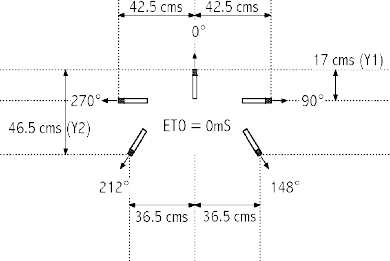

| TABLE 3a | ||||
| FRONT TRIPLET COVERAGE 50° + 50° | ||||
| Microphone orientation | Distance between microphones | X coordinates | Y1 coordinates (for both left and right microphones) | Microphone Position Time Offset (MPTO) |
| 90° (R) |
61 cm
|
+ 58.5 cm |
17 cm
|
-28.5°
|
| 270° (L) | – 58.5 cm | |||
| 80° (R) |
62 cm
|
+ 58 cm |
21 cm
|
-20°
|
| 280° (L) | – 58 cm | |||
| 72° (R) |
63.9 cm
|
+ 59 cm |
24 cm
|
-13°
|
| 288° (L) | – 59 cm | |||
| 60° (R) |
66.5 cm
|
+ 61 cm |
27 cm
|
-6°
|
| 300° (L) | – 61 cm | |||
| 50° (R) |
69.5 cm
|
+ 63 cm |
29.5 cm
|
No Offset
|
| 310° (L) | – 63 cm | |||
| 40° (R) |
72.5 cm
|
+ 65 cm |
32 cm
|
+6°
|
| 320° (L) | – 65 cm | |||
From the above table (Front Triplet Coverage of 50° + 50°), note « the microphone orientation », « X » coordinates and « Y1 » coordinates for the desired configuration of the Front Triplet. Then choose the combination « distance / angle » from the table below and note the distance between the left and right Back Pair microphones, and their orientation, and the « Y2 » coordinate of the Back Pair (with respect to the front-facing centre microphone). This is all the information that you need to set up this « no offset » array which covers the complete surround sound field in five segments (the Left and Right Front Segments of 50° each, two side segments of 114° and a back segment of 32°.
| TABLE 3b | ||||||
| LATERAL PAIRS | BACK PAIR | |||||
| Lateral Segment Coverage | Electronic Time Offset (ETO) | Back Segment Coverage | Mic orientation | Angle between mics | Distance between mics | Y2 coord |
|
114°
|
No offset
|
32°
|
140°(R) |
80°
|
103 cm
|
44 cm
|
| 220°(L) | ||||||
No other solutions exist for values of Back Segment Coverage, these being the only values where the intersection between the physical parameters of the microphone array and the psychoacoustical limits is possible.
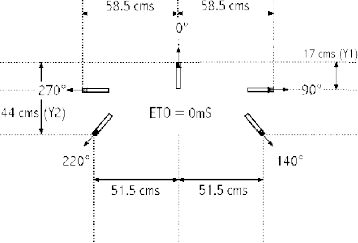
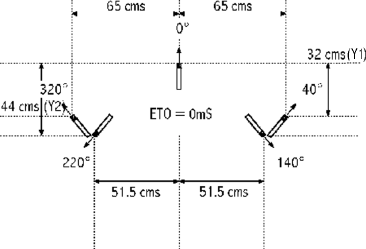
| TABLE 4a | ||||
| FRONT TRIPLET COVERAGE 90° + 90° | ||||
| Microphone orientation | Distance between microphones | X coordinates | Y1 coordinates (for both left and right microphones) | Microphone Position Time Offset (MPTO) |
| 90° (R) |
24.5 cm
|
+ 17.3 cm |
17.3 cm
|
No Offset
|
| 270° (L) | – 17.3 cm | |||
| 80° (R) |
27 cm
|
+ 17.5 cm |
20.5 cm
|
+9.2°
|
| 280° (L) | – 17.5 cm | |||
| 72° (R) |
29.5 cm
|
+ 18 cm |
23.5 cm
|
+18°
|
| 288° (L) | – 18 cm | |||
| 60° (R) |
32.5 cm
|
+ 19 cm |
26.5 cm
|
+24.5°
|
| 300° (L) | – 19 cm | |||
| 50° (R) |
35.5 cm
|
+ 20 cm |
29 cm
|
+30.5°
|
| 310° (L) | – 20 cm | |||
| 40° (R) |
38.5 cm
|
+ 22 cm |
31.5 cm
|
+35.5°
|
| 320° (L) | – 22 cm | |||
From the above table (Front Triplet Coverage of 90° + 90°), note « the microphone orientation », « X » coordinates and « Y1 » coordinates for the desired configuration of the Front Triplet. Then choose the combination « distance / angle » from the table below and note the distance between the left and right Back Pair microphones, their orientation, and the « Y2» coordinate of the Back Pair (with respect to the front-facing centre microphone) and corresponding ETO (Electronic Time Offset). Please note that a negative ETO means that the Back Pair will be delayed with respect to the Front Triplet by the requisite amount. This is all the information that you need to set up the array.
| TABLE 4b | ||||||
| LATERAL PAIRS | BACK PAIR | |||||
| Lateral Segment Coverage | Electronic Time Offset (ETO) | Back Segment Coverage | Mic orientation | Angle between mics | Distance between mics | Y2 coord |
|
45°
|
– 0.98 ms
|
90°
|
140°(R) |
80°
|
27 cm
|
103 cm
|
| 220°(L) | ||||||
|
50°
|
– 0.9 ms
|
80°
|
140°(R) |
80°
|
32 cm
|
94 cm
|
| 220°(L) | ||||||
|
55°
|
– 0.94 ms
|
70°
|
135°(R) |
90°
|
36 cm
|
90 cm
|
| 225°(L) | ||||||
|
60°
|
– 1.05 ms
|
60°
|
135°(R) |
90°
|
45 cm
|
86.5 cm
|
| 225°(L) | ||||||
|
65°
|
– 1.23 ms
|
50°
|
130°(R) |
100°
|
55 cm
|
87.5 cm
|
| 230°(L) | ||||||
|
70°
|
– 1.5 ms
|
40°
|
120°(R) |
120°
|
68 cm
|
98 cm
|
| 240°(L) | ||||||
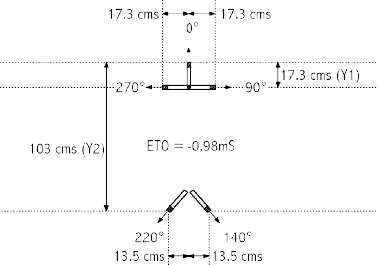
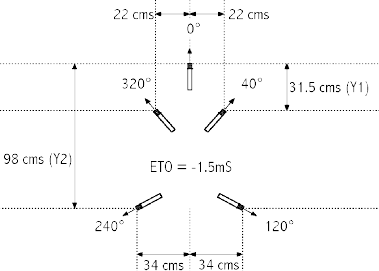
| TABLE 5a | ||||
| FRONT TRIPLET COVERAGE 80° + 80° | ||||
| Microphone orientation | Distance between microphones | X coordinates | Y1 coordinates (for both left and right microphones) | Microphone Position Time Offset (MPTO) |
| 90° (R) |
29.5 cm
|
+ 24 cm |
17.5 cm
|
-9°
|
| 270° (L) | – 24 cm | |||
| 80° (R) |
32 cm
|
+ 24.5 cm |
20.5 cm
|
No Offset
|
| 280° (L) | – 24.5 cm | |||
| 72° (R) |
34.5 cm
|
+ 25 cm |
23.5 cm
|
+8°
|
| 288° (L) | – 25 cm | |||
| 60° (R) |
35 cm
|
+ 26.5 cm |
26.5 cm
|
+15°
|
| 300° (L) | – 26.5 cm | |||
| 50° (R) |
40 cm
|
+ 27.5 cm |
29.5 cm
|
+22°
|
| 310° (L) | – 27.5 cm | |||
| 40° (R) |
43 cm
|
+ 29.5 cm |
31.5 cm
|
+27°
|
| 320° (L) | – 29.5 cm | |||
From the above table (Front Triplet Coverage of 80° + 80°), note « the microphone orientation », « X » coordinates and « Y1 » coordinates for the de- sired configuration of the Front Triplet. Then choose the combination « distance / angle » from the table below and note the distance between the left and right Back Pair microphones, their orientation, and the « Y2 » coordinate of the Back Pair (with respect to the front-facing centre microphone) and corresponding ETO (Electronic Time Offset). Please note that a negative ETO means that the Back Pair will be delayed with respect to the Front Triplet by the requisite amount. This is all the information that you need to set up the array.
| TABLE 5b | ||||||
| LATERAL PAIRS | BACK PAIR | |||||
| Lateral Segment Coverage | Electronic Time Offset (ETO) | Back Segment Coverage | Mic orientation | Angle between mics | Distance between mics | Y2 coord |
|
55°
|
– 0.75 ms
|
90°
|
140°(R) |
80°
|
27 cm
|
85.3 cm
|
| 220°(L) | ||||||
|
60°
|
– 0.7 ms
|
80°
|
140°(R) |
80°
|
32 cm
|
80 cm
|
| 220°(L) | ||||||
|
65°
|
– 0.7 ms
|
70°
|
135°(R) |
90°
|
36 cm
|
76.5 cm
|
| 225°(L) | ||||||
|
70°
|
– 0.6 ms
|
60°
|
135°(R) |
90°
|
45 cm
|
71 cm
|
| 225°(L) | ||||||
|
75°
|
– 0.7 ms
|
50°
|
130°(R) |
100°
|
55 cm
|
71 cm
|
| 230°(L) | ||||||
|
80°
|
– 0.76 ms
|
40°
|
120°(R) |
120°
|
68 cm
|
76 cm
|
| 240°(L) | ||||||
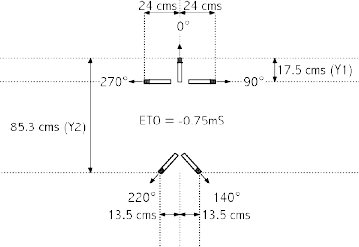
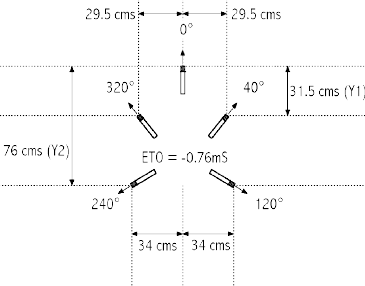
| TABLE 6a | ||||
| FRONT TRIPLET COVERAGE 72° + 72° | ||||
| Microphone orientation | Distance between microphones | X coordinates | Y1 coordinates (for both left and right microphones) | Microphone Position Time Offset (MPTO) |
| 90° (R) |
35 cm
|
=+ 30.5 cm |
17 cm
|
-15°
|
| 270° (L) | – 30.5 cm | |||
| 80° (R) |
37 cm
|
=+ 31 cm |
20.5 cm
|
-6°
|
| 280° (L) | – 31 cm | |||
| 72° (R) |
39 cm
|
=+ 31.5 cm |
23 cm
|
No offset
|
| 288° (L) | – 31.5 cm | |||
| 60° (R) |
42.5 cm
|
=+ 33 cm |
26.5 cm
|
=+9°
|
| 300° (L) | – 33 cm | |||
| 50° (R) |
45 cm
|
=+ 34 cm |
29.5 cm
|
=+15.5°
|
| 310° (L) | – 34 cm | |||
| 40° (R) |
48.5 cm
|
=+ 36.5 cm |
31.5 cm
|
=+20.9°
|
| 320° (L) | – 36.5 cm | |||
From the above table (Front Triplet Coverage of 72° + 72°), note « the microphone orientation », « X » coordinates and « Y1 » coordinates for the desired configuration of the Front Triplet. Then choose the combination « distance / angle » from the table below and note the distance between the left and right Back Pair microphones, their orientation, and the « Y2 » coordinate of the Back Pair (with respect to the front-facing centre microphone) and corresponding ETO (Electronic Time Offset). Please note that a negative ETO means that the Back Pair will be delayed with respect to the Front Triplet by the requisite amount.
And inversely, a positive ETO means that the Front Triplet is delayed with respect to the Back Pair. This is all the information that you need to set up the array.
| TABLE 6b | ||||||
| LATERAL PAIRS | BACK PAIR | |||||
| Lateral Segment Coverage | Electronic Time Offset (ETO) | Back Segment Coverage | Mic orientation | Angle between mics | Distance between mics | Y2 coord |
|
63°
|
+ 0.2 ms
|
90°
|
140°(R) |
80°
|
27 cm
|
67.5 cm
|
| 220°(L) | ||||||
|
68°
|
+ 0.07 ms
|
80°
|
140°(R) |
80°
|
32 cm
|
63.5 cm
|
| 220°(L) | ||||||
|
72°
|
No offset
|
70°
|
135°(R) |
90°
|
39 cm
|
60 cm
|
| 225°(L) | ||||||
|
78°
|
– 0.19 ms
|
60°
|
135°(R) |
90°
|
45 cm
|
60.1 cm
|
| 225°(L) | ||||||
|
83°
|
– 0.36 ms
|
50°
|
130°(R) |
100°
|
55 cm
|
61.1 cm
|
| 230°(L) | ||||||
|
88°
|
– 0.43 ms
|
40°
|
120°(R) |
120°
|
68 cm
|
62 cm
|
| 240°(L) | ||||||


| TABLE 7a | ||||
| FRONT TRIPLET COVERAGE 60° + 60° | ||||
| Microphone orientation | Distance between microphones | X coordinates | Y1 coordinates (for both left and right microphones) | Microphone Position Time Offset (MPTO) |
| 90° (R) |
46 cm
|
+ 42.5 cm |
17 cm
|
-23°
|
| 270° (L) | – 42.5 cm | |||
| 80° (R) |
48 cm
|
+ 43.5 cm |
20.5 cm
|
-15°
|
| 280° (L) | – 43.5 cm | |||
| 72° (R) |
50.2 cm
|
+ 44.5 cm |
23 cm
|
– 7°
|
| 288° (L) | – 44.5 cm | |||
| 60° (R) |
53 cm
|
+ 46 cm |
26.5 cm
|
No Offset
|
| 300° (L) | – 46 cm | |||
| 50° (R) |
56 cm
|
+ 47.5 cm |
29.5 cm
|
+7°
|
| 310° (L) | – 47.5 cm | |||
| 40° (R) |
59 cm
|
+ 50 cm |
31.5 cm
|
+12°
|
| 320° (L) | – 50 cm | |||
From the above table (Front Triplet Coverage of 60° + 60°), note « the microphone orientation », « X » coordinates and « Y1 » coordinates for the de- sired configuration of the Front Triplet. Then choose the combination « distance / angle » from the table below and note the distance between the left and right Back Pair microphones, their orientation, and the « Y2 » coordinate of the Back Pair (with respect to the front-facing centre microphone) and corresponding ETO (Electronic Time Offset). Please note that a negative ETO means that the Back Pair will be delayed with respect to the Front Triplet by the requisite amount. And inversely, a positive ETO means that the Front Triplet is delayed with respect to the Back Pair. This is all the information that you need to set up the array.
| TABLE 7b | ||||||
| LATERAL PAIRS | BACK PAIR | |||||
| Lateral Segment Coverage | Electronic Time Offset (ETO) | Back Segment Coverage | Mic orientation | Angle between mics | Distance between mics | Y2 coord |
|
75°
|
+ 0.69 ms
|
90°
|
140°(R) |
80°
|
27 cm
|
57 cm
|
| 220°(L) | ||||||
|
80°
|
+ 0.56 ms
|
80°
|
140°(R) |
80°
|
32 cm
|
53 cm
|
| 220°(L) | ||||||
|
85°
|
+ 0.42 ms
|
70°
|
135°(R) |
90°
|
39 cm
|
51 cm
|
| 225°(L) | ||||||
|
90°
|
+ 0.28 ms
|
60°
|
135°(R) |
90°
|
45 cm
|
49 cm
|
| 225°(L) | ||||||
|
95°
|
+ 0.1 ms
|
50°
|
130°(R) |
100°
|
55 cm
|
49 cm
|
| 230°(L) | ||||||
|
100°
|
– 0.1 ms
|
40°
|
120°(R) |
120°
|
68 cm
|
52 cm
|
| 240°(L) | ||||||
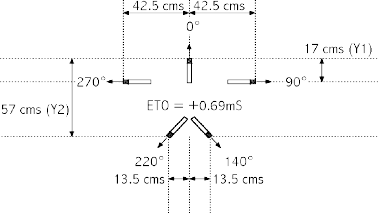
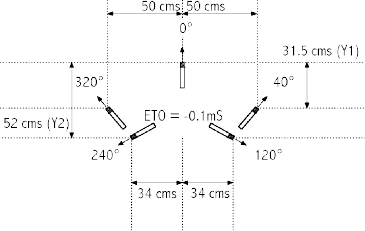
| TABLE 8a | ||||
| FRONT TRIPLET COVERAGE 50° + 50° | ||||
| Microphone orientation | Distance between microphones | X coordinates | Y1 coordinates (for both left and right microphones) | Microphone Position Time Offset (MPTO) |
| 90° (R) |
61 cm
|
+ 58.5 cm |
17 cm
|
-28.5°
|
| 270° (L) | – 58.5 cm | |||
| 80° (R) |
62 cm
|
+ 58 cm |
21 cm
|
-20°
|
| 280° (L) | – 58 cm | |||
| 70° (R) |
63.9 cm
|
+ 59 cm |
24 cm
|
-13
|
| 288° (L) | – 59 cm | |||
| 60° (R) |
66.5 cm
|
+ 61 cm |
27 cm
|
-6°
|
| 300° (L) | – 61 cm | |||
| 50° (R) |
69.5 cm
|
+ 63 cm |
29.5 cm
|
No Offset
|
| 310° (L) | – 63 cm | |||
| 40° (R) |
72.5 cm
|
+ 65 cm |
32 cm
|
+6°
|
| 320° (L) | – 65 cm | |||
From the above table (Front Triplet Coverage of 50° + 50°), note « the microphone orientation », « X » coordinates and « Y1 » coordinates for the desired configuration of the Front Triplet. Then choose the combination « distance / angle » from the table below and note the distance between the left and right Back Pair microphones, their orientation, and the « Y2 » coordinate of the Back Pair (with respect to the front-facing centre microphone) and corresponding ETO (Electronic Time Offset). Please note that a positive ETO means that the Front Triplet is delayed with respect to the Back Pair by the requisite amount. This is all the information that you need to set up the array.
| TABLE 8b | ||||||
| LATERAL PAIRS | BACK PAIR | |||||
| Lateral Segment Coverage | Electronic Time Offset (ETO) | Back Segment Coverage | Mic orientation | Angle between mics | Distance between mics | Y2 coord |
|
90°
|
No solution
|
80°
|
140°(R) |
80°
|
32 cm
|
–
|
| 220°(L) | ||||||
|
95°
|
No solution
|
70°
|
135°(R) |
90°
|
36 cm
|
–
|
| 225°(L) | ||||||
|
100°
|
No solution
|
60°
|
135°(R) |
90°
|
45 cm
|
–
|
| 225°(L) | ||||||
|
105°
|
= + 0.5 ms
|
50°
|
130°(R) |
100°
|
55 cm
|
42.5 cm
|
| 230°(L) | ||||||
|
110°
|
= + 0.28 ms
|
40°
|
120°(R) |
120°
|
68 cm
|
45.5 cm
|
| 240°(L) | ||||||
|
114°
|
No solution
|
32°
|
140°(R) |
120°
|
103 cm
|
52.5 cm
|
| 220°(L) | ||||||
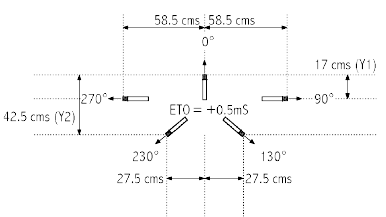
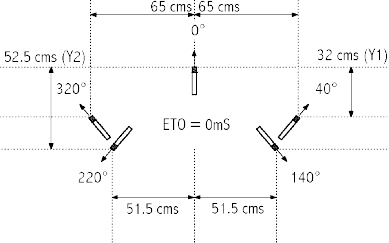
References
- 1 1984: 74th AES Convention in Paris – preprint 2072
« The Stereophonic Zoom, A Practical Approach to determining the Characteristics of a Spaced Pair of Microphones » by Michael Williams. - 2 1987: 82nd AES Convention in London – preprint 2466
« Unified Theory of Microphone Systems for Stereophonic Sound Recording » by Michael Williams - 3 1990: 88th AES Convention in Montreux – preprint 2931
« Operational Limits of the Variable M/S Stereophonic Microphone System » by Michael Williams - 4 1991: 91st AES Convention in New York – preprint 3155
« Early Reflections and Reverberant Field Distribution in Dual Microphone Stereophonic Sound Recording Systems » by Michael Williams - 5 1991: 91st AES Convention in New York – preprint 3157
« Microphone Arrays for Natural Multiphony » by Michael Williams. - 6 1992: 92nd AES Convention in Vienna – preprint 3252
« Frequency Dependent Hybrid Microphone Arrays for Stereophonic Recording » by Michael Williams. - 7 « The Stereophonic Zoom » by Michael Williams
- 8 1999: 107th AES Convention in New York: Preprint 4997
« Microphone Array Analysis for Multichannel Sound Recording » by Michael Williams and Guillaume Le Dû - 9 2000: 108th AES Convention in Paris: Preprint 5157
« Multichannel Microphone Array Design » by Michael Williams and Guillaume Le Dû - 10 2000: VDT in Hannover
« Loudspeaker Configuration and Channel Crosstalk in Multichannel Microphone Array Design » by Michael Williams and Guillaume Le Dû - 11 2001: 110th AES Convention in Amsterdam: preprint 5336
« The Quick Reference Guide to Multichannel Microphone Arrays, Part 1: using Cardioid Microphones » by Michael Williams and Guillaume Le Dû - 12 2002: 112th AES Convention in Munich: preprint 5567
« Multichannel Microphone Array Design: Segment Coverage Analysis above and below the Horizontal Reference Plane » by Michael Williams
Michael Williams is an independent audio consultant based in Paris. He started his professional career at the BBC Television Studios in London in 1960. In 1965, he moved to France to work for ”Societe Audax” in Paris, developing loudspeakers for professional sound and television broadcasting, and later worked for the ”Conservatoire National des Arts et Metiers” in the adult education television service. In 1980, he became a free-lance instructor in Audio Engineering and Sound Recording Practice, working for most of the major French national television and sound broadcasting companies, as well as many training schools and institutions. He is an active member of the Audio Engineering Society and has published many papers on Stereo and Multichannel Recording Systems over the past twenty years. He is, at present, the AES Publications Sales Representative in Europe.
Guillaume Le Dû is an engineer for Radio France.
Originally written in 2002 for Microphone Data (Rycote Microphone Windshields Ltd and Human Computer Interface)
© 2023 Micpedia
